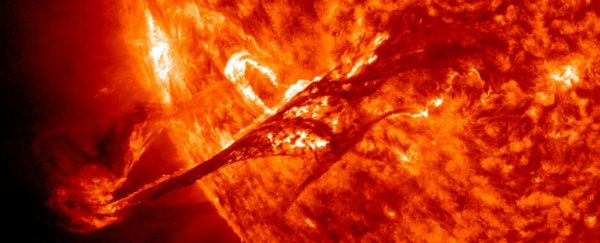For centuries, scientists have puzzled over the violent, unpredictable outbursts of plasma that spew out of our Sun - sometimes so aggressively that they trigger aurorae and can interfere with telecommunications here on Earth.
But an international team of researchers thinks they might have finally identified the mechanism driving these eruptions - and contrary to previous assumptions, both large and small solar flares seem to be caused by the same, dramatic process.
If the new hypothesis is confirmed, scientists might finally be able to not only predict when these solar outbursts are due, but also whether they could unleash damage on Earth.
Right now, we know that the Sun follows a roughly 11-year pattern of activity, but more precise predictions about when and where solar flares will occur are difficult to make.
"A greater understanding of solar eruptions at all scales could ultimately help in better predicting the Sun's activity," said lead researcher, Peter Wyper from Durham University in the UK.
"Large-scale coronal mass ejections (CMEs), where huge amounts of solar plasma, radiation and high energy particles are being released, can influence the space around them, including the space near to Earth. They can interfere with satellite communications, for example, so it is beneficial for us to be able to understand and monitor this activity."

The team studied 3D simulations of the two main types of solar eruption: coronal jets, which are relatively small bursts of plasma; and the much larger CMEs, which blast huge clouds of plasma and magnetic fields into space at high speeds.
Researchers already knew that both types of eruption involved snake-like filaments of dense plasma low in the Sun's atmosphere, but no one had been able to figure out what caused the eruptions at such different scales.
Thanks to the new models, the team was able to show that both sizes of jet are triggered to erupt when the magnetic field lines in the surface of the Sun above them break and rejoin - a process known as magnetic reconnection.
You can see the filaments in yellow in the animation of the process below:
This is the same process that was already known to produce huge CMEs, but it hadn't been linked to the small-scale coronal jets up until now.
"It was previously thought that there were different drivers for the varying scales of eruptions from the Sun, but our research provides a theoretical universal model for this activity, which is very exciting," said Wyper.
The researchers are calling their new hypothesis the 'breakout model', because basically it involves a stressed filament of plasma pushing relentlessly at its magnetic restraints before ultimately breaking through and escaping into space.
So if magnetic reconnection causes both CMEs and coronal jets, what makes them so different in scale?
The team showed that the strength and structure of the magnetic field around the filament determines the type of eruption that occurs.
Based on this information, they could better predict what the Sun is going to do.
That's important because CMEs don't just play a role in the spectacular light shows we see at Earth's magnetic poles, but they can also eject enough electromagnetic radiation that it can affect radio transmissions, satellite communications, and possibly endanger astronauts.
"The breakout model unifies our picture of what's going on at the Sun," said one of the researchers, Richard DeVore from NASA's Goddard Space Flight Centre.
"Within a unified context, we can advance understanding of how these eruptions are started, how to predict them, and how to better understand their consequences."
For now, though, this hypothesis remains untested. The next step is for the researchers to confirm their model with high-resolution observations of the solar atmosphere - data that's not currently available, but hopefully will be as new space telescopes come online over the new few years.
The research has been published in Nature.
